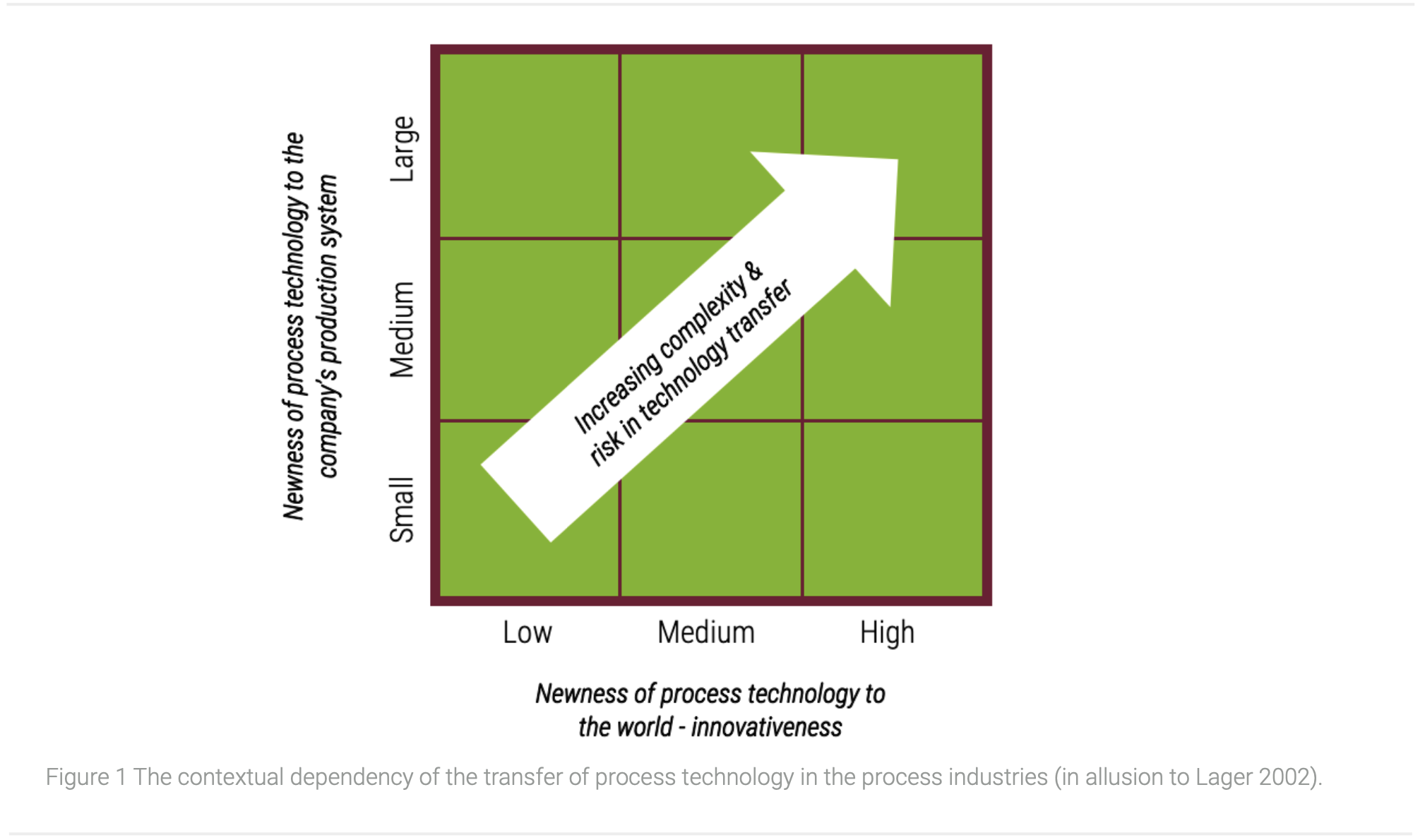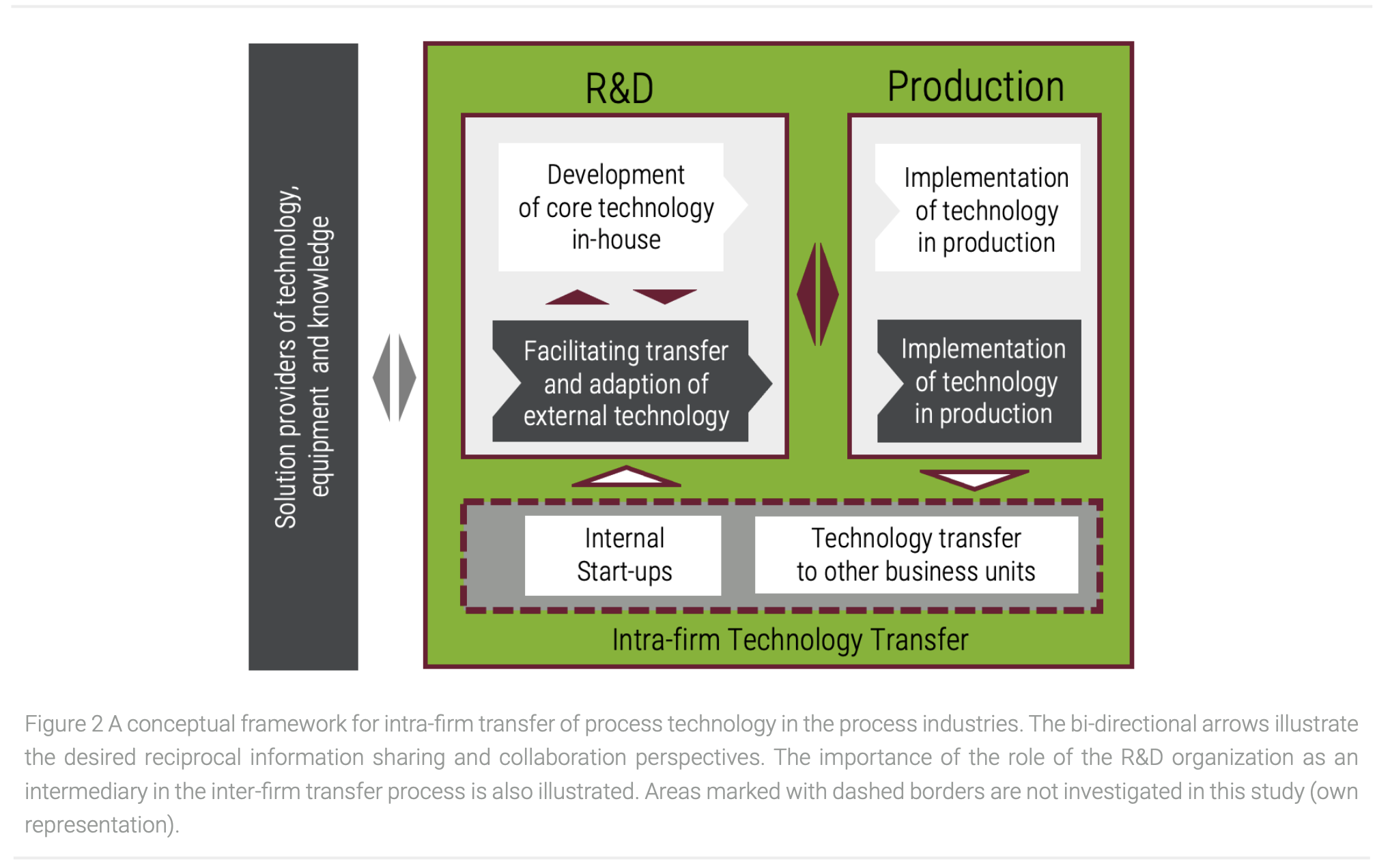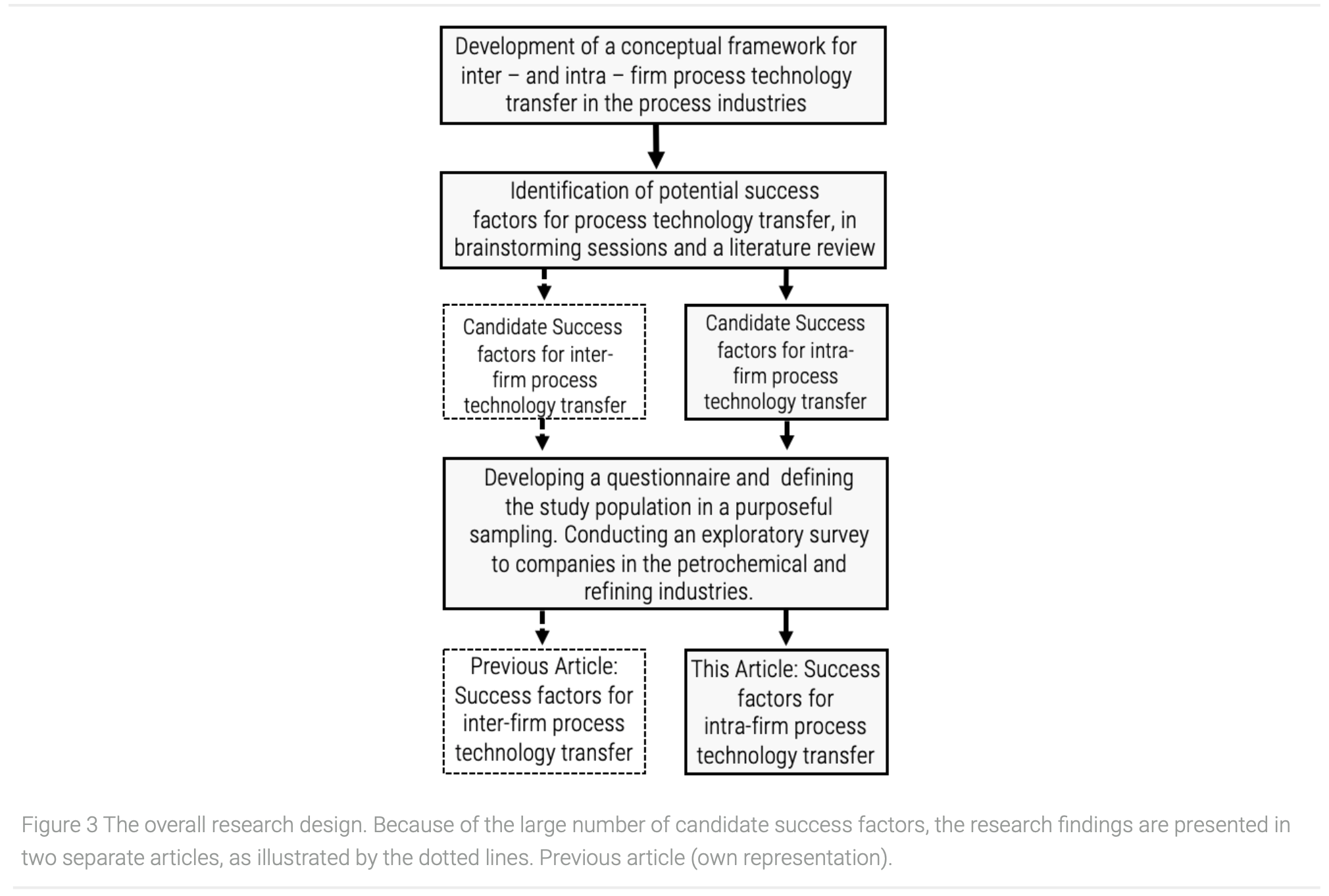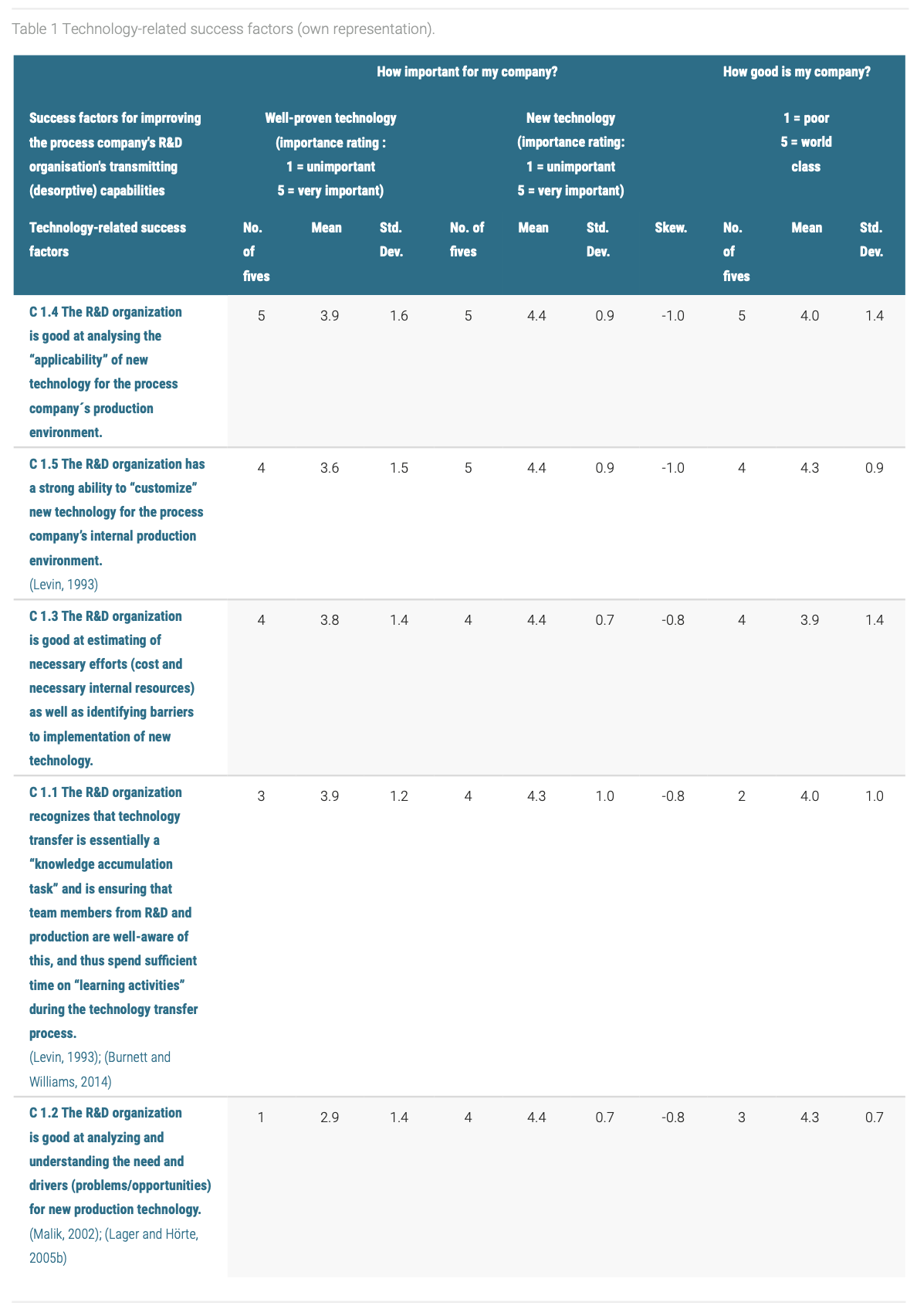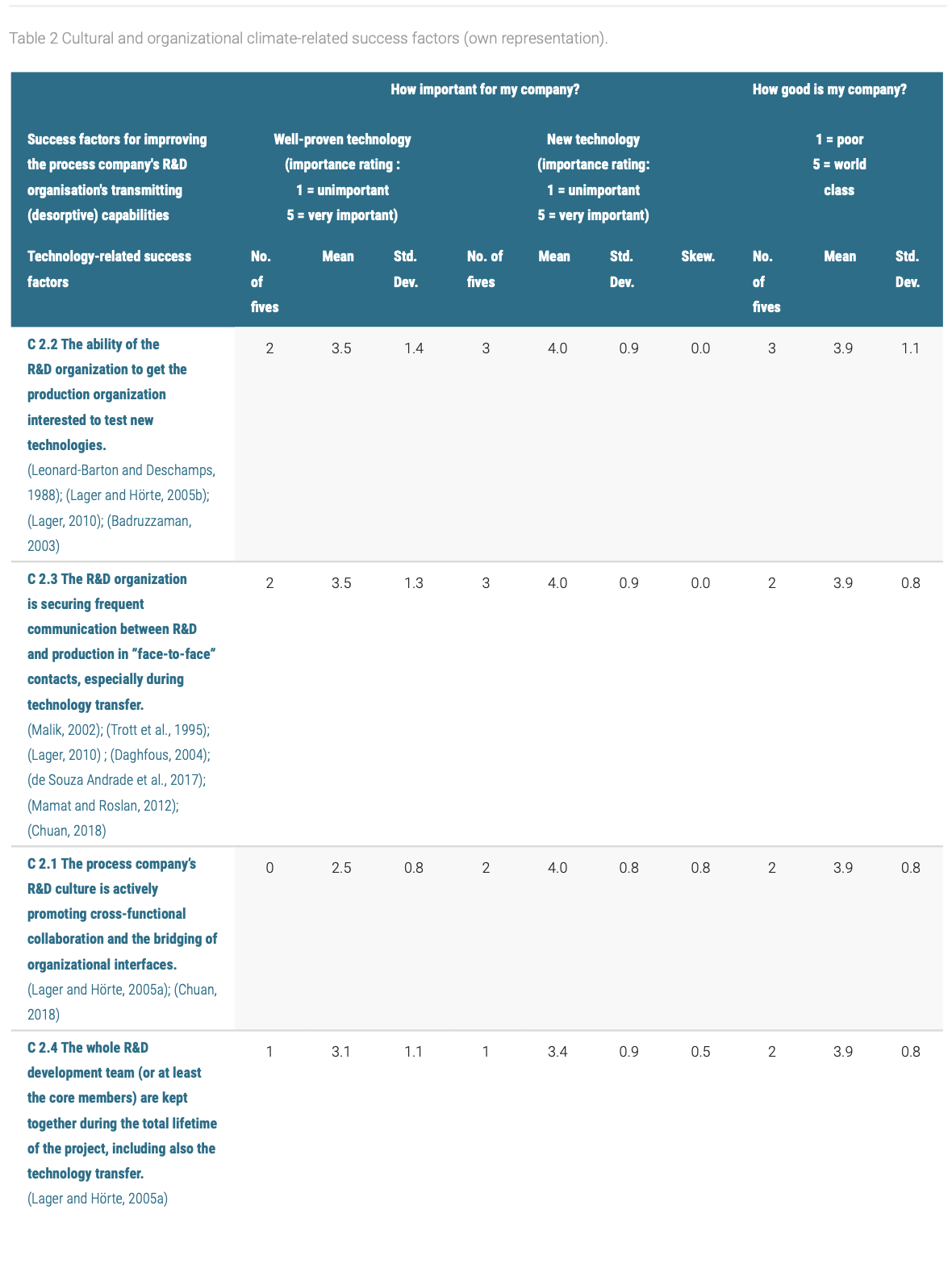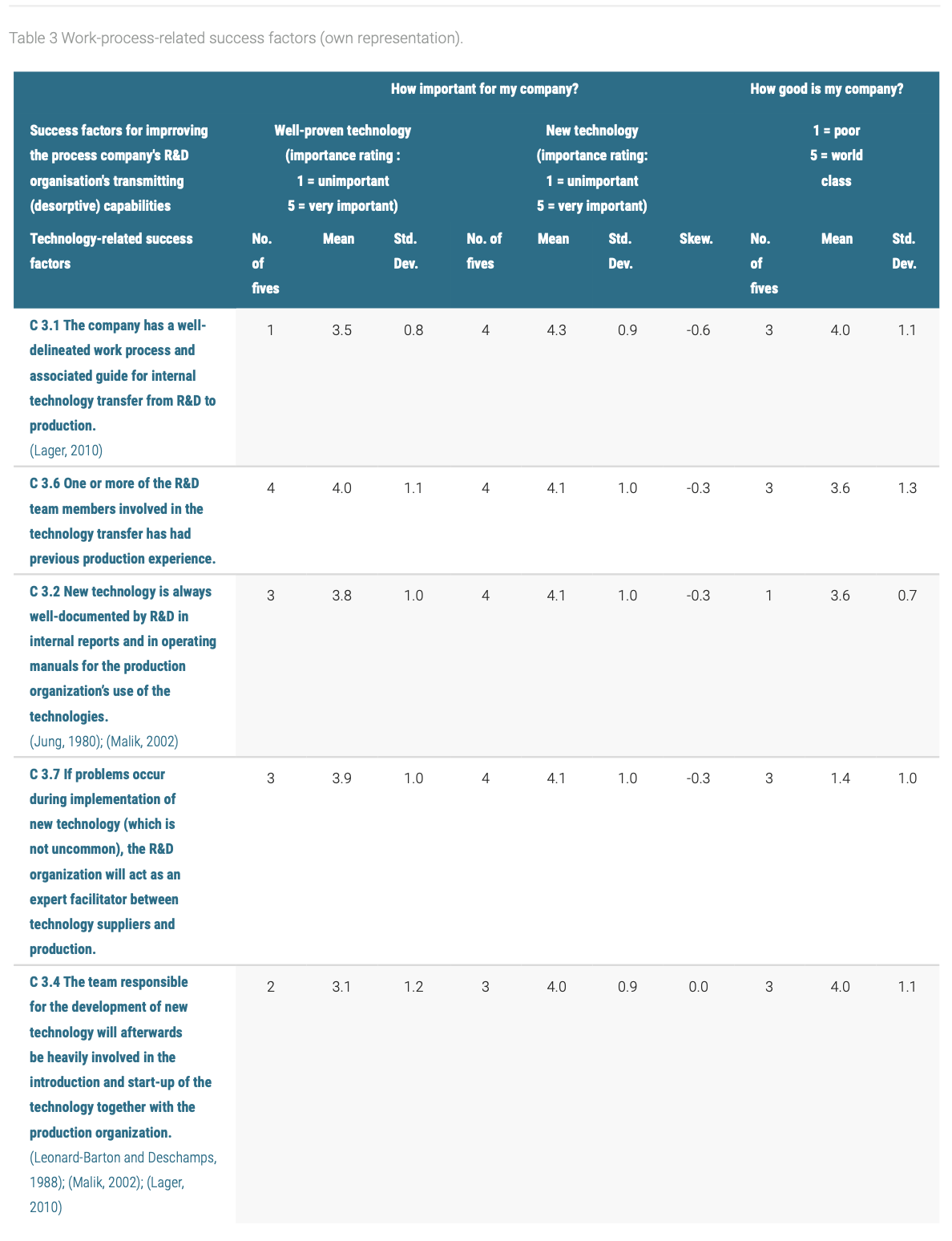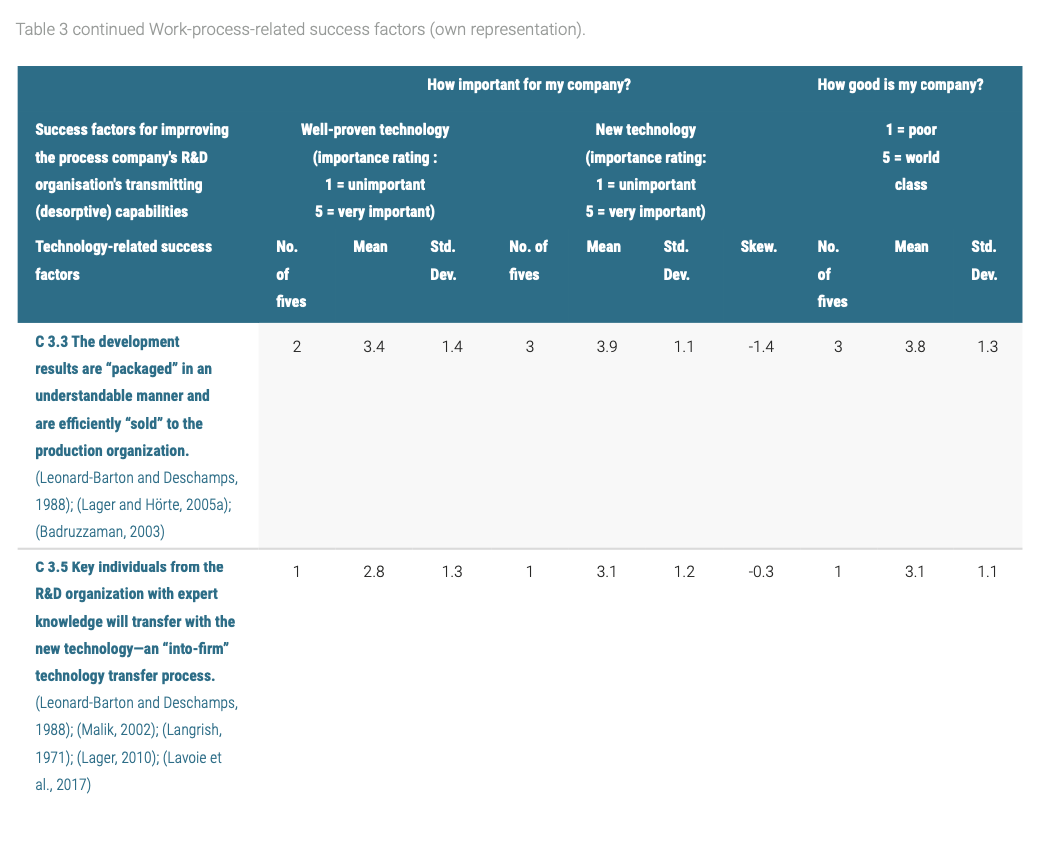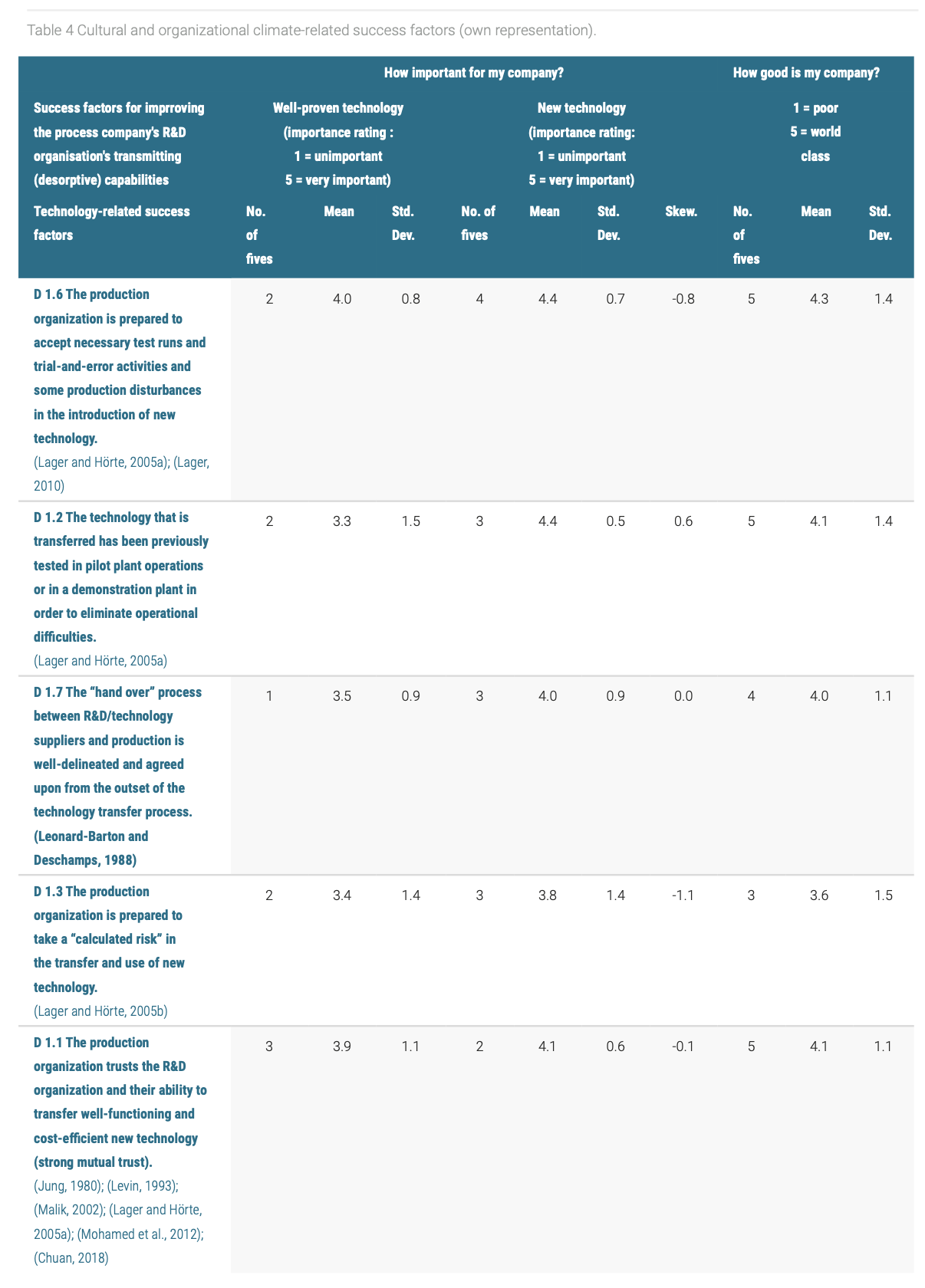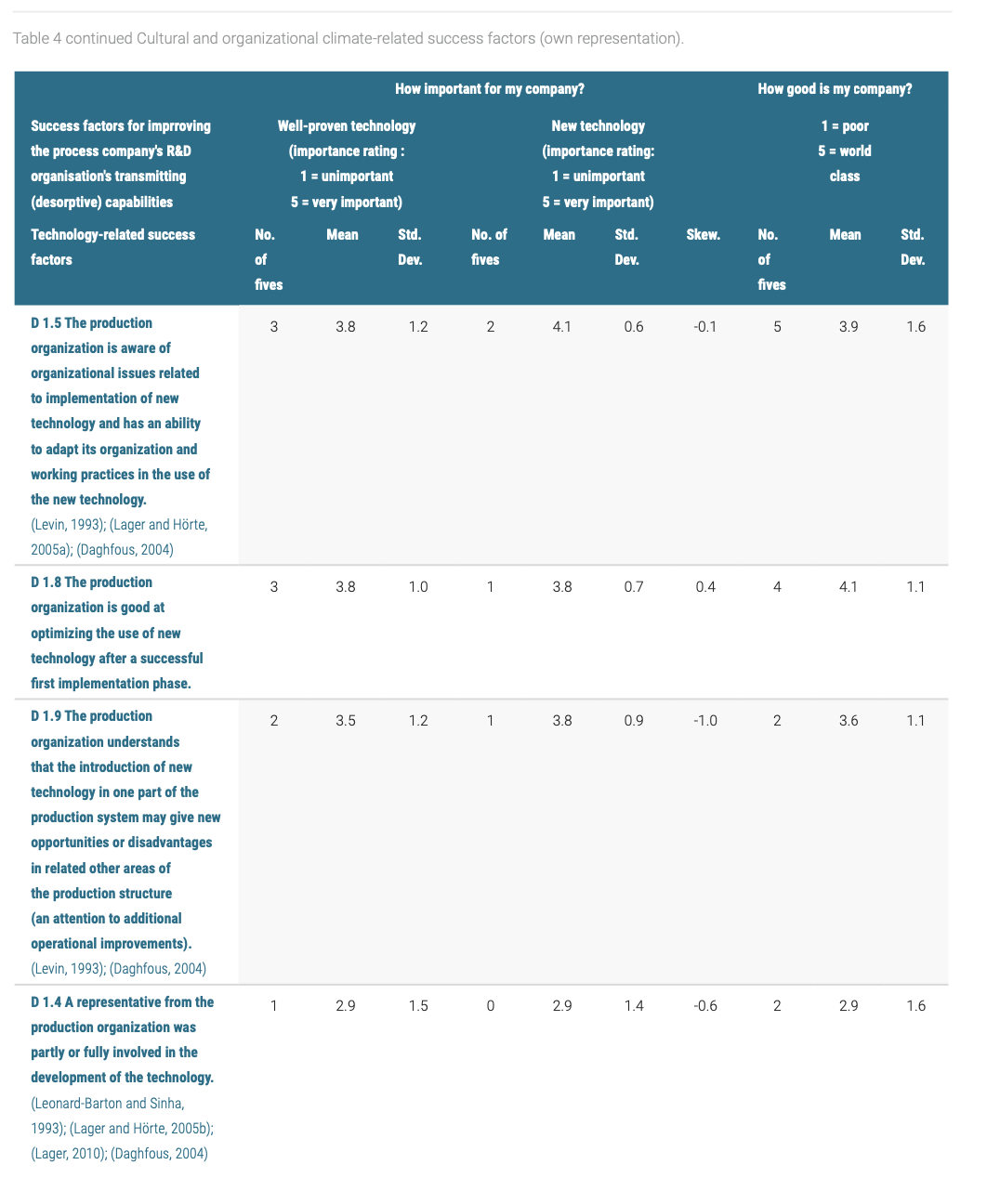Success factors for intra-firm process technology transfer, and a petrochemical outlook
Abstract
The introduction of existing, improved or radically new process technology in the process industries is not finished until the technology is implemented and operating well within the company’s organization and premises; a fact of growing importance in the perspective of digital transformation. In a literature review of technology transfer models, studies of intra-firm process technology transfer were found to be scarce, and this article, aims to close this gap. Relying on the author’s industrial experiences and a literature review, 25 success factors for intra-firm process technology transfer were developed and operationalized for company use. To serve as an illustrative case in order to facilitate company implementation of the results, the success factors were afterwards included in a questionnaire in an exploratory survey to professionals in the petrochemical industry. The findings indicate that companies would benefit from the development and use of an internal guide for inter-firm process technology transfer. The holistic hierarchic structure of the success factors could not only be used as components in such a manual but also serve as a “checklist” for companies’ internal improvement programs for process technology transfer.
1 Introduction
The cluster of industries generally denoted as “the process industries” spans multiple industrial sectors, constitutes a substantial part of the entire manufacturing industry (Lager, 2017); in Appendix 1 the concept process industries is defined in detail. One of the principal differences between companies in the process industries and those in other manufacturing industries is that the products supplied to them and often delivered from them are materials or ingredients rather than components or assembled products (Frishammar et al., 2012). The final step in process development is the transfer of the results to production; a point when efforts shift from the R&D organization to the production function. This phase will generally involve modifications of existing production equipment, new process installations or even the erection of a complete new production plant. However, bringing new plants, production processes, minor unit operations or single equipment items on stream is not only a production and financial risk, but an activity that is always also a safety-critical endeavor (Bagsarian, 2001).
One should thus not overlook the installation and startup of even minor process equipment integrated in big plants since, regardless of size, there is always a potential of a major process and production disturbance (Lager, 2012). In conclusion, this phase is not just handing new technology over to production (Bagsarian, 2001, Gans et al., 1983, Leitch, 2004), since this phase can represent the part of the total development process that can make the difference between project success and failure. It thus argued that more attention should be paid to this final part of process innovation; the intra-firm technology transfer process. Moreover, since the company’s digital transformation and digitalization also will depend on successful inter- and intra-firm transfer of technology and systems, excellence in technology transfer is of increased industrial importance. While management of the technology transfer process is generally an issue of concern in all manufacturing industries (Burnett and Williams, 2014, Distanont et al., 2018, Lavoie et al., 2017), it is of particular interest for process technology transfer in the process industries because of high fixed asset costs and a need for high operational availability during process technology transfer.
In spite of its importance for theory building and for industrial production and innovation, process-industrial innovation is unfortunately still under-researched, and in a literature review of technology transfer and technology transfer models, studies of intra-firm process technology transfer were found to be scarce; this article aims to close this gap. Success factors for intra-firm transfer of process technology are defined in this study as: “specific working methods and best practices that lead to successful outcomes of technology transfer” (Lager and Hörte, 2005b), which is related to the construct of effectiveness in technology transfer. Furthermore, previously presented barriers for technology transfer are converted into success factors by identifying how they could be overcome.
The point of departure for this study was the development of a conceptual framework for intra-firm transfer of process technology in the process industries. Afterwards, based on the authors’ previous industrial experiences in technology transfer and a review of extant literature on technology transfer, 25 candidate success factors for intra-firm process technology transfer were iteratively developed. These success factors were afterwards used in the development of a questionnaire for an exploratory survey to professionals in the petrochemical industry in order to serve as an illustrative case to facilitate company implementation and use.
Apart from companies’ general management of the technology transfer process and the use of a number of success factors for excellence in management of process technology transfer, the complexity of the technology to be transferred is generally one out of several contextual determinants for successful technology transfer. The matrix in Figure 1 thus illustrates the influence of the newness of the process technology to the company’s production system and the newness of the process technology to the world on the technology transfer process complexity (Lager, 2002). In this study, the importance ratings of individual success factors were consequently differentiated in the inquiry for both “well-proven technology” and “new technology”.
Success factors for improving a process company’s R&D organization’s desorptive (transmitting) capabilities (Lichtenthaler, 2006) were categorized in this study as technology-related, work-process-related, and knowledge- and culture-related. Success factors for improving a process company’s production organization’s absorptive (receiving) capabilities (Cohen and Levinthal, 1990), however, were more knowledge- and culture-related.
The remainder of this article is organized as follows. In the next section, technology transfer in general and intra-firm technology transfer in particular are reviewed. Afterwards, the development of a conceptual framework, research design and the methodological development of success factors for process technology transfer are presented. The empirical findings from a survey of companies in the petrochemical industries are then introduced, including individual success factors and their related supportive references. The results are then discussed, followed by managerial implications and conclusions.
2 A literature review and the development of a conceptual framework for process technology transfer
In this article, the distinction proposed by Stewart (1987) is followed, and the term of “technology diffusion” is thus used to refer to the spontaneous flow or meandering of information and knowledge about a technology, whereas the term “technology transfer” is used to refer to a company’s intentional transfer of technology and knowhow. This article focuses on “technology transfer”; for a recent comprehensive treatment of the topical area, see, for example, Tidd (2010).
2.1 Introducing the concept of technology transfer
The importance of technology transfer is today generally considered unquestionable; however, John Mason Mings (1999) presented two contrasting perspectives:
Technology transfer is sometimes suggested as an El Nino in business, government, industry and even education decision-making, and for some it has meant disruption, dislocation, and danger. For others, technology transfer has been the vanguard of progress and an inexhaustible fountain for productivity, empowerment, and convenience.
While technology transfer is important, it certainly may have both advantages and disadvantages; thus, excellence in the management of the technology transfer process is consequently of industrial importance from an organizational perspective on innovation management. Defining technology as comprising the physical object (artifact), the process of making this object and the necessary knowledge to operate the object (Levin, 1993), this study views the transfer of technology as not only the physical movement of equipment and the transfer of the necessary skills to operate the equipment but also an understanding of necessary embedded knowledge and cultural skills; these elements are not generally distinctive and separable but rather form a seamless web.
In a taxonomy for technology transfer, the following categories of transfers were identified by Reisman (1989): “Scientific disciplines, Professions, Industries, Economic sectors, Geographic regions and Societies/Countries”. Reisman and Zhao (1991) further suggested the inclusion of the dimensions “duration, cost, nature and modality (organizational forms for collaboration)”. The lesson to be learned here is that, in modelling technology transfer or in the development of new conceptual frameworks, it should be specified for what type of technology transfer and what kind of transfer environment the results are supposed to be relevant for, as well as which kinds of transfer mechanisms, success factors, or determinants that is referred to. Khabiri et al. (2012), in search of a technology transfer model for SMEs, propose a slightly modified version of the model proposed by Malik (2002), and for a recent review of technology transfer models, see Kundu and Bhar (2015).
2.2 Technology transfer at a company-to-company level
The process of introducing existing, improved, or newly developed technology in a company is not finished until the technology is implemented and operating well within the company’s organization and premises. By analogy, just as the final phase of product development is the launch of a new product on the market, the final phase of process development is the implementation and start-up of a new technology — that is, technology transfer. In a study of barriers to technology transfer, at a personal level of analysis, Jung (1980) concludes that an organization that wants to minimize barriers must observe a number of factors, including looking for personalities that facilitate technology transfer, rewarding good technology transfer behavior, building and maintaining trust, and improving documentation. Trott et al. (1995) likewise recognize the importance of non-routine activities and effective communication between credible boundary-spanning individuals. This area is further discussed by Leonard-Barton and Deschamps in their study of managerial influence in the implementation of new technology (Leonard-Barton and Deschamps, 1988, Leonard-Barton and Kraus, 1985).
In a study of internal technology transfer and the determinants for success, Leonard-Barton and Sinha (1993) observed that important success factors include not only the cost, quality and compatibility of the technology but also user involvement in the development and adoption by the developers and users of both the technical system itself and the workplace. They further observed that a technical system transferred from a development site to a user site always encounters differences in context, equipment, operators’ skills, and so on. Moreover, even if developers successfully meet their original technical objectives, new technology often requires fine-tuning in the operating environment. Malik (2002) concluded that barriers to technology transfer could be overcome by a personnel approach (temporary or permanent transfer of the knowledge owner to the user group), an observation that is supported by Langrish (1971). He further recognize that barriers or likely-to-inhibit factors include lack of interest in the project, the “not invented here” syndrome, lack of people transfer, lack of perceived market benefit, lack of trust, lack of training, lack of incentives, language barriers, and perception of new technology as a threat (Malik, 2002).
A study of critical success factors for technology transfer in the petrochemical industry (Badruzzaman, 2003) acknowledges the importance of securing recipient “buy-in”, providing an early demonstration of expected benefits, and ensuring the transferee’s prior knowledge of the technology. Chai et al. (2004), in a study of process innovation, identified the effort required for the “adoption of the technology for local use” and the “degree of technology embeddedness in the original organizational setting” as critical factors. In an organizational learning perspective, Daghfous (2004) identifies a number of factors for an improved inter-firm transfer of technology, such as the inclusion of a transferee representative in the technology development, the importance of prior knowledge of the technology at the transferee company, and a need to identify necessary organizational implications.
In a study of internal technology transfer in complex product development (Magnusson and Johansson, 2008), the importance of the “system aspects” is stressed. This fact, highlights the corresponding “system aspect” in the transfer of process technology into complex process-industrial production systems. In two articles (Part 1 and Part 2), Lager and Hörte (2005a, Lager and Hörte, 2005b) studied success factors for the development of process technology in the process industries, and a number of success factors that relate well to technology transfer are noted in the presentation of these success factors in the empirical findings. In the book Managing Process Innovation: From idea generation to implementation, Lager (Lager, 2010) also presents success factors related to process technology transfer; for example, “strong mutual trust exists between the development organization and the production organization”.
In a review of critical success factors in manufacturing industries, Mamat and Roslan (2012) concluded that the most important overall factor was good communication, but they noted that the transfer of key personnel, selection of a proper transfer mode, and compatibility in partnership were also important. Modelling the technology transfer process in the petroleum industry, Mohamed et al. (2012) point out the importance of the transferee having good prior knowledge in the area of technology, as well as the importance of mutual trust between the transferor and the transferee. In a study of knowledge transfer in the oil and gas industry, Burnett and Williams (2014) recognized that successful development of technology is in large part due to personal interactions and, in many cases, informal sharing of both tacit and explicit knowledge. Searching for “catalysts” of intra-firm technology transfer, Petronia et al. (2015) recognized the importance of the transfer of tacit knowledge, risk estimation and the link to previous testing of the technology. Moreover, Chuan (2018) identified a number of challenges to intra-firm technology transfer, such as:
- Managing tacit information
- Avoidance of “not invented here”
- Lack of people transfer and “face-to-face” communication
- Culture and trust
In the development of a technology transfer framework for the energy sector, Lavoie et al. (2017) considered the following capabilities to be important: “training at the donor’s site, assigning experienced staff, overcoming language barriers, early interaction with transferor, future revenue estimates, and risk analysis”. In a review of critical success factors for university–company technology transfer, de Souza Andrade et al. (2017) identified the importance of technology training and communication abilities. The latter factor was also highlighted in a study by Behrane and Grobbelar (2018). Distanont et al. (2018) identified the following factors affecting technology transfer in the petrochemical industry: “strong knowledge of the technology by the transferor, crossing language barriers, classroom training, face-to-face learning, and on-the-job training”.
2.3 A conceptual framework for intra-firm transfer of process technology
In an early seminal paper titled “Innovation and learning: the two faces of R&D,” Cohen and Levinthal (1990), introduced the concept of “absorptive capacity”:
We argue that while R&D obviously generates innovations, it also develops the firm’s ability to identify, assimilate and exploit knowledge from the environment – what we call a firm’s “learning” or “absorptive” capacity.
In a later review and reconceptualization, Zahra and George (2002) distinguished between potential and realized absorptive capacity. The antonymous concept is “desorptive capacity”, defined by Lichtenthaler (2006) as “a firm’s ability to identify technology transfer opportunities and to transfer technology to the recipient”. The ability of an R&D organization to excel in intra-firm technology transfer is to a large extent dependent on its transmitting capabilities for knowledge and technology, which in today’s vocabulary are often called its “desorptive capabilities”. In a similar vein, the process company’s production organization’s receiving capabilities for new or improved internal technology can be called its “absorptive capabilities”. In Figure 2, a conceptual framework for intra-firm process technology transfer has been outlined. However, please note that success factors related to the areas marked with dashed borders were not targeted in this study.
2.3.1 Success factors for intra-firm transfer of process technology
In the perspective of intra-firm transfer of process technology, Figure 2 illustrates that the process company’s research and development (R&D) department both internally develops “core technology” in-house (Dussauge et al., 1987) and also often serves as an intermediary in the transfer of external technology into its own company’s production department. In both cases, the company’s R&D department must have good desorptive capability in its transfer of technology to production. In a review of critical success factors for university–company technology transfer, de Souza Andrade et al. (2017) identified the importance of technology training and communication abilities. The latter factor was also highlighted in a study by Behrane and Grobbelar (2018). In this study, success factors for improving the desorptive capabilities of the process company’s R&D department were categorized as:
- Technology-related success factors
- Work-process-related success factors
- Cultural and organizational climate-related success factors
However, the production department must also have a strong absorptive capability in order to successfully learn, master and implement new technology into the production system. Success factors for improving the absorptive capabilities of the process company’s production department have been identified and categorized in a similar manner as for the R&D department. While a production department’s desorptive capacity giving feedback to the company’s R&D department is generally also desirable, this capability was not included in this study, nor were the two complementary activities of “Internal Start-ups” and “Technology transfer to other business units”. While Giroud and Mirza (2006) studied the latter activity from a company–country transfer perspective, Holden and Konishi (1996), in a study of Japanese and US organizations, identified the following factors as central to successful inter-firm management of technology transfer:
- Excellent project management skills (tact, flexibility and diplomacy in interactions between organizations with different practices, structures and cultures).
- Strong and effective communication paths.
- Selection of partners based on complementary technology and business interest (long-term partnership).
“Internal start-ups” are the opposite of “external spin-outs” but are related to “external spin-ins” in an inter-firm process technology transfer perspective. In a study by Festel (2013), such internal start-ups were identified as a new approach for companies’ internal technology transfer from research departments to business units focused on commercial operations to overcome innovation barriers within companies (i.e., “into-firm” diffusion).
2.4 Research questions for intra-firm technology transfer
The following research questions have been identified:
RQ1 What are the success factors for a process company’s R&D organization’s transmitting (desorptive) capabilities for process technology to the company’s production organization?
RQ2 What are the success factors for process companies’ production organization’s receiving (absorptive) capabilities for process technology?
In this article, only success factors for intra-firm technology transfer and the related survey results are presented.
3 Research design and methodological considerations
Lacking a suitable framework for process technology transfer, and based on the results from the literature review, a conceptual framework for intra-firm process technology transfer in the process industries was thus initially developed, as shown in Figure 2 in the previous section. The overall research strategy and design adopted to answer the research questions for this study is presented in Figure 3. Because of the large number of candidate success factors, the research findings are presented in two separate articles; this article presents the results on intra-firm process technology transfer.
In this study, both authors acted not only as management researchers but also in their capacity as industry practitioners, since both have more than 20 years of general or management experience operating in the process industries (Mineral Industries and Petroleum Refining/Petrochemical Industries). Thus, in a grounded theory perspective (Glaser and Strauss, 1967), both authors were able to contribute first-hand knowledge in the topical area in the development of the candidate success factors, thus “letting the practitioners speak”, in the words of Binder and Edwards (2010). Such prior understanding can have many advantages for a study of this kind, as expressed by Markus (1977):
The problem is how to get beyond the superficial or the merely salient, becoming empirically literate. You can understand little more than your own evolving mental map allows. A naive, indifferent mental map will translate into global, superficial data and interpretations – and usually into self-induced bias as well. You have to be knowledgeable to collect good information.
It is argued that the authors’ familiarity with the process industrial context and the subject area has not only improved the construct validity of the selected candidate success factors but also secured the identification of knowledgeable informants – a fact which will be discussed in the following sub-section.
3.1 The methodological development of a hierarchy of candidate success factors
After the development of the conceptual framework, a number of potential success factors were initially developed based on the authors’ previous industrial experiences with technology transfer in two different sectors of the process industries and an in-depth literature review of technology transfer in general and inter-firm technology transfer in particular. In this context, the construct of “success factor” was defined and later presented to the respondents as: “Specific working methods and best practices that lead to successful outcomes of technology transfer”. (For a more extensive presentation and discussion of success factors in the management of process innovation, see, e.g., (Lager and Hörte, 2005a, Lager and Hörte, 2005b). A number of potential success factors relevant for the process technology transfer processes were thus initially developed. Additionally, previously identified barriers to process technology transfer were developed into success factors by considering how they could be overcome.
Afterwards, the potential success factors were iteratively revised, further refined, and reformulated into more understandable candidate success factors for process industry professionals. All candidate success factors were initially separated into inter-firm and intra-firm success factors; thereafter, in a clustering exercise, they were finally arranged in hierarchical structures. The success factors for R&D organization’s transmitting capabilities were in a bottom-up clustering exercise categorized as “technology-related”, “work-process-related” and “knowledge- and culture-related”, while the production organization’s absorptive capabilities related mainly to cultural and organizational climate-related factors . All candidate success factors for intra-firm process technology transfer are integrated in the presentation of the research findings in the following section. Associated supportive literature references, if any, for the individual success factors are presented together with each success factor.
3.2 Testing the industrial usability of the candidate success factors in an exploratory survey
Using surveys for the collection of information from managers in manufacturing industries is becoming increasingly cumbersome because of a generally experienced “survey fatigue” among industry professionals. Potential respondents’ low willingness to participate in surveys thus makes it difficult to use classical probability sampling techniques in management research. An alternative approach to overcome this difficulty, based on the researchers’ own knowledge and personal judgement, is to locate knowledgeable groups of information-rich informants as respondents. Such a nonprobability sampling strategy does not serve the classical objective of generalization of research findings, but it does make it possible to improve the understanding of the subject matter through input from a limited number of respondents. Such a theoretical sampling, also called “purposeful sampling”, is thus the common strategy for case selection in multiple case studies. The sampled individuals are then approached as “key informants” rather than respondents as in a classical inquiry (Wagner et al., 2010 pp. 583):
“Key informants report their perceptions of these constructs, rather than personal attitudes or behaviours. In this respect, informants need to be distinguished from respondents who give information about themselves as individuals.”
In this respect, the respondents in this survey can thus be viewed as “multiple informants” (see, e.g., Barrett and Oborn, (2018).
3.2.1 The sampling strategy for the exploratory survey
In order to explore the industrial usability of the candidate success factors for process technology transfer, the decision was made to test them on a group of industry professionals from the “family” of process industries. The intention was not only to explore their industrial relevance in process technology transfer but also to provide an illustrative case, thus facilitating a further industrial understanding and deployment of the success factors as an instrument for enhanced process technology transfer. Since one of the authors works in a company in the petrochemical and refinery industrial sector and planned to attend a major international conference for the Petrochemical and Refining Industries, this offered an opportunity to recruit respondents for the exploratory survey. The decision was thus made to approach selected delegates at the GCPA Research & Innovation Summit (GPCA, 2017) to supply some empirical information, and their companies became the selected “study population”.
Although the “population of interest” is the international process industries in general and the global petrochemical and refining industry in particular, the decision was made to deploy this somewhat unconventional sample selection strategy for the study in order to overcome the problem described above. The attending author’s first-hand knowledge of these industries and network of industry professionals visiting the conference simplified the selection of the study population, as well as the contact with knowledgeable company respondents, which aided in the later conducting of the survey. During the conference, the attending author reviewed the list of delegates, approached selected informants, and gauged their willingness to respond to a future inquiry. All candidate informants responded positively, and the author collected their business cards and explained the intention of the upcoming survey. The final group of respondents were representatives from equipment suppliers, service providers, and oil and gas operating companies in the international arena.
3.2.2 The questionnaire and response rate
The framework and related success factors to be deployed in the questionnaire were first thoroughly reviewed and discussed in a separate pilot test in one of the authors’ companies. English was the language used in the questionnaires for all respondents, since English is often the “working language” in the industrial corporations targeted in this survey. The respondents were asked in the questionnaire to give their “importance ratings” for each candidate success factor using a five-point ordinal scale (1 = Not important; 2 = Of minor importance; 3 = Important; 4 = Very important; 5 = Decisive to success), but were also encouraged to present potential new success factors. In order to ascertain whether the importance ratings varied between process technology transfer of “Well-proven technology (incremental development)” and “New technology (more radical developments)”, the respondents were asked to give separate importance ratings for each kind of technology transfer. Additionally, they were also asked to benchmark their organization’s capability level in process technology transfer for each success factor on a five-point ordinal scale (1 = Poor; 2 = Not so good; 3 = Good; 4 = Very good; 5 = Excellent).
The questionnaires were distributed by electronic mail, and the respondents could answer directly using the attached document. The questionnaire was answered by only one respondent from each company; thus, in some multidivisional organizations, the answers may represent only one division of the organization. The respondents were sent reminders via e-mail about six weeks after the questionnaires were sent. The final response rate was about 20 % (14 responses) out of 72 questionnaires sent out. In the discussion, possible non-response bias is further discussed.
4 Presentation of the candidate success factors and the empirical findings
The empirical results from this study are presented in Tables 1- 4. For each success factor, the mean value and standard deviation are presented, and for “New technology” their Skewness is also presented. The total number of “fives” reported by the respondents are also included, and the success factors have been rearranged in ranking order, starting with the success factor with the highest number of fives using only the importance ratings of “new technology”. The letters and numbers related to each success factor are only inserted to make them traceable to the inquiry.
4.1 Success factors for improving the process company’s R&D organization’s transmitting (desorptive) capabilities
Comments from respondents:
- Not sure of the issue C1.1
- R&D in the current low price oil and gas market is not a major priority as clients are not willing to pay. R&D is driven by client willingness to pay extra for advanced technology.
One comment from a respondent:
I think it is essential that a company develops a culture of innovation among its staff to enable the acceptance of new technology. The company should have some incentives for persons in production to taking the risk of change, which is associated with the process of transfer of a new technology.
4.2 Success factors for improving the process company’s production organization’s absorptive (receiving) capabilities
One comment from a respondent:
An additional success factor could be the importance of testing, feedback and technology improvement. The technology supplier is dependent on the receiving company allowing full testing, especially if that testing requires operating the technology off design for extended periods.
5 Discussion
The inquiry touched upon an important area for many informants (respondents), thus stimulating the further development of the conceptual framework. Kumar et al. (1993 pp.3) elaborate the key informant concept as follows:
“Researchers do not select informants to be representative of the members of a studied organization in any statistical sense. Rather, they are chosen because they are supposedly knowledgeable about the issue being researched and able and willing to communicate about them.”
This study is inquiring about intra-firm process technology transfer in the process industries and is thus, in strict adherence to the recommendations by Reisman (1989) previously presented in Section 2.1, accurately specifying “for what type of technology” and “for what part of transfer environment” the results are relevant; furthermore in clarifying relevant “success factors and transfer mechanisms”.
5.1 From candidate success factors to critical success factors
In this study a number of potential success factors were initially developed, relying on the authors’ previous industrial experiences with process technology transfer in two different sectors of the process industries. The development was supported by a literature review of technology transfer in general and more specifically intra-firm technology transfer. Afterwards, the potential success factors were refined and reformulated into a number of candidate success factors that were included in the questionnaire in the exploratory survey. In the literature on success factors, both notations are often used in an interchangeable manner.
In this study a distinction is made between candidate success factors (nice-to-have capability) and critical success factors (must have capability). In company implementation and use of the presented success factors, it is thus suggested that a company should rate the importance and benchmark each success factor in a “company contingency perspective”. However, the exploratory results from the survey are intended to give a supplementary “out-of the box” perspective on company internal importance ratings. Based on the empirical findings from the survey, two top-ranked success factors within each category group, have been selected and re-named as critical success factors. The selection criterion between candidate and critical success factors is thus somewhat arbitrary in this study, but is primarily deployed in order to illustrate the conceptual idea behind a necessary company importance rating and classification of success factors.
5.1.1 Critical success factors for improving the process company’s R&D organization’s desorptive (transmitting) capabilities
Technology-related success factors
C 1.4 The R&D organization is good at analysing the “applicability” of new technology for the process company’s production environment.
C 1.5 The R&D organization has a strong ability to “customize” new technology for the process company’s internal production environment.
Cultural and organizational climate-related success factors
C 2.2 The ability of the R&D organization to get the production organization interested to test new technologies.
C 2.3 The R&D organization is securing frequent communication between R&D and production in ”face-to-face” contacts, especially during technology transfer.
Work-process-related success factors
C 3.1 The company has a well-delineated work process and associated guide for internal technology transfer from R&D to production.
C 3.6 One or more of the R&D team members involved in the technology transfer has had previous production experience.
5.1.2 Critical success factors for improving process companies’ production organization’s absorptive (recieving) capabilities
D 1.6 The production organization is prepared to accept necessary test runs and trial-and-error activities and some production disturbances in the introduction of new technology.
D 1.2 The technology that is transferred has been previously tested in pilot plant operations or in a demonstration plant in order to eliminate operational difficulties.
Referring to the comments from respondents, a new success factor was proposed recognizing the importance of an allowance period of operating the technology for extended periods. This issue is related to success factor D.1.8.
5.1.3 Differences in importance ratings between individual groups and between “well-proven technology” and “new technology”, and benchmarking of company capabilities
Comparing the results from individual groups of success factors, using the often more discriminating measure of the number of “fives” instead of importance rating figures, the cultural issues seem to have less industrial importance than technology-related issues. Furthermore, the desorptive capabilities of the R&D organization are regarded to be more important than the absorptive capabilities of the production organization. Moreover, the importance ratings of success factors for new technology are generally higher compared with the importance ratings of well-proven technology; while this is a rather reasonable outcome this is also the reason behind selection of success factors for new technology in the ranking. It certainly also highlights the importance of analyzing technology transfer in a “newness dimension” in reference to previously presented Figure 1. The importance ratings of company capabilities for technology transfer are generally very high, but one must consider the possibility that the respondents have a general bias in their estimation of their own companies’ technology transfer capabilities.
5.2 Major findings and theoretical contribution
One criterion of “good research” is how usable the research results are. This question is further stressed in the presentation of “grounded theory”, where the pragmatic criterion of truth is its usability (Glaser and Strauss, 1967). Related to this philosophical standpoint, Whetten (1989) and Corley and Gioia (2011) cogently defined “theoretical contribution” as the ability to produce thinking that is original in its insight and useful in its application. With regard to the notion of “originality,” a theoretical contribution can be categorized as advancing understanding either incrementally or in a more revelatory or surprising manner (Corley and Gioia, 2011). Regarding practical utility, Corley and Gioia suggest “prescriptions for structuring and organizing around a phenomenon.”
First, success factors for intra-firm process technology transfer in the cluster of process industries have, to the best of the authors’ knowledge, not been previously presented and operationalized for company deployment and use. The candidate success factors are new findings that often have more or less strong support not only from the literature review but also from the high importance ratings of the informants. The presented success factors sometimes lack any support from the literature review, but are new potential success factors based on the authors’ practical experiences. However, the high importance ratings from the informants qualify them as candidate success factors. When success factors have support from the literature review, this does not mean that they have been explicitly formulated before; only the the general idea has been recognized before. In that respect, the research results advance the scientific position, since, in reference to Corley and Gioia (2011), they “improve the conceptual rigor or the specificity of an idea and/or enhance its potential to be operationalized and tested.”
Second, it is indicated that the research findings can be deployed both for improving company capabilities in process technology transfer and in the development of a company guiding framework for technology transfer. In consideration of the “utility” aspect, it is thus advocated that the presented success factors provide industry professionals with an instrument and tool for “structuring around a phenomenon” — the area investigated in this study. It is further argued that the results from this study thus fulfil the criteria for a theoretical contribution since the results have originality and the utility is high for both academics and practitioners.
5.3 Research limitations and further research
A number of different aspects of technology transfer in general, and the transfer of process technology in the process industries in particular, have been studied. However, this study does not address specific contextual issues like project complexity and the industrial environment for technology transfer in detail; nor does it address success factors at a personal level of analysis. Moreover, the detailing and formalization of individual stages and components of a technology transfer work process are only touched upon. The development and refinement of the individual success factors, supplemented with the high ratings of all success factors in the exploratory survey, only indicate that the success factors are understandable and can be favorably deployed in one sector of the process industries; the petrochemical industries.
A consequence of a low response rate is not only that the sample size is reduced but also that the non-responding companies may represent a select group that could give deviant answers. There are three major causes of non-response: no contact, refusal to answer and inability to answer, and in this study 11 company representatives could not be contacted, 8 company representatives declined to answer because of confidentiality reasons. Nonetheless, the non-responding company characteristics do not indicate a bias in the empirical results. However, the low response rate makes it difficult to draw any conclusions regarding the “critical success factors” or the generalizability of the findings to other sectors of the process industries. The total number of candidate success factors can thus to be regarded as a number of propositions to be tested in further research.
The low response rate makes it difficult to draw any firm conclusions regarding the generalizability of the results to other sectors of the process industries and even the petrochemical industries as such. However, there is no reason to suspect that participation in this conference as such should give any bias on respondents’ answers. In future research, the usability of the success factors in other sectors of the process industries would be of interest to study, since in the era of company digital transformation and work process digitalization, excellence in technology transfer will continue to be of increasing importance.
6 Managerial implications
The high importance ratings of the candidate success factors not only indicate their apparent relevance for industry professionals but also suggest that they could be deployed as a “checklist” for companies’ intra-firm process technology transfer. Furthermore, by utilizing the proposed success factors as company candidate success factors in an internal company survey, specific company importance ratings of individual success factors can be established, and company capabilities in all areas can be benchmarked.
To the best of the authors’ knowledge, the presented success factors have not been previously reported in the literature, including the success factor: The company has a well-delineated work process and associated guide for internal technology transfer from R&D to production. This success factor received high importance ratings among cultural and organizational climate-related factors, indicating that process companies could benefit from the use of an internal guide and manual for carrying out process technology transfer projects. The success factors that have been developed in this study could be useful components in the development of such a manual. Moreover, the results can serve as guidelines both for new company technology transfer projects and in a company improvement program for technology transfer. From the perspective of company digital transformation and digitization, the importance of company excellence in intra-firm technology transfer must also be recognized and highlighted.
7 Conclusions
In this study, success factors for intra-firm process technology transfer have been developed for use in the family of process industries. As a point of departure and in light of the lack of a suitable theoretical framework, a simplified conceptual framework was initially developed. The necessary reciprocal information sharing (organizational transmitting and receiving capabilities), highlights the misleading nature of the concept “technology transfer”, as it seems to indicate a one-way communication process. Based on the authors’ previous industrial experiences with the transfer of process technology in particular, and an in-depth literature review of technology transfer, 25 candidate success factors were developed and operationalized for process-industrial use. The success factors were thereafter used in the development of a questionnaire for an exploratory survey disseminated to professionals in the petrochemical industry in order to serve as an illustrative case to facilitate company implementation and use of the presented results.
Critical success factors for improving the process company’s R&D organization’s desorptive (transmitting) capabilities were categorized in the bottom-up clustering exercise as technology-related, work-process-related, and cultural & knowledge related. Of these, one of the top-ranked success factors was: the R&D organization is good at analyzing the “applicability” of new technology for the process company’s production environment. Critical success factors for improving the process company’s production organization’s absorptive (receiving) capabilities were in the clustering exercise categorized only as cultural & organizational climate related. Of these, one of top-ranked success factors was: the production organization is prepared to accept necessary test runs and trial-and-error activities and some production disturbances in the introduction of new technology.
The general high importance ratings of nearly all candidate success factors indicate that they could be deployed in a “checklist” for company intra-firm process technology transfer. The findings indicate that process companies would benefit from the use of an internal guide and manual for carrying out process technology transfer projects. The success factors that have been developed in this study could be useful components in the development of such a manual. Moreover, the results can serve as guidelines both for new company technology transfer projects and in a company improvement program for technology transfer.
To the best of the authors’ knowledge, success factors for intra-firm process technology transfer in the cluster of process industries have not previously been presented and operationalized for company deployment and use. It is argued that the results from this study thus fulfil the criteria for a theoretical contribution, since the results have originality and their utility is high for both academics and practitioners.
Acknowledgements
We sincerely thank all company representatives that took part in the survey and spent their valuable time responding to the questionnaire. Many thanks are due to Mrs. Gunilla Bergdahl for research assistance and help with the survey. The permission from ADNOC Refining to publish this article is also recognized and appreciated. The financial support from the XPRES project is gratefully acknowledged. Last but not least, the authors sincerely acknowledge valuable ideas and suggestions from anonymous referees.
References
Badruzzaman, A. (2003): Critical success factors for technology transfer: Sharing a perspective. SPE Asia Pacific Oil and Gas Conference. Indonesia: Society of Petroleum Engineers.
Bagsarian, T. (2001): Avoiding startup stumbles. Iron Age New Steel, 17, pp. 16-19.
Barrett, M. and Oborn, E. (2018): Bridging the research-practice divide: Harnessing expertise collaboration in making wider set ofcontributions. Information and Organization, 28, pp. 44-51.
Behane, T. and Grobbelaar, S. S. (2018): The process of intra-firm technology transfer: A case study of a marine mining company. South African Journal of Industrial Engineeering, 29.
Binder, M. and Edwards, J. S. (2010): Using grounded theory method for theory building in operations management research: a study on inter-firm relationship governance. International Journal of Operations & Production Management, 30, pp. 232-260.
Burnett, S. and Williams, D. (2014): The role of knowledge transfer in technological innovation: an oil and gas industry perspective. Knowledge Management Research & Practice, 12, pp. 133-144.
Chai, K.-H., Gregory, M. J. and Shi, Y. S. (2004): An Exploratory Study of Intrafirm Process Innovation Transfer in Asia. IEEE Transactions on Engineering Management, 51, pp. 364-373.
Chuan, R. (2018): Intra-firm technology transfer is one of the most knowledge-intensive activity in MNC. SING35010 International Competitiveness and Innovation. University of Manchester.
Cohen, W. M. and Levinthal, D. A. (1990): Absorptive Capacity: A new Perspective on Learning and Innovation. Administrative Science Quarterly, 35, pp. 128-152.
Corley, K. G. and Gioia, D. A. (2011): Building theory about theory building: What constitutes a theoretical contribution. Academy of Management Review, 36, pp. 12-32.
Daghfous, A. (2004): Organizational learning, knowledge and technology transfer: a case study. The Learning Organization, 11, pp. 67-83.
De Souza Andrade, H., Borges Silva, M., Moraes Rosa, A. C., Gatto Chimendes, V. C. and De Freitas Chagas Jr, M. (2017): Risk and Success Factors in Technology Transfer. Int. Journal of Engineering Research and Application, 7, pp. 66-71.
Distanont, A., Khongmalai, O. and Kritpipat, P. (2018): Factors affecting technology transfer performance in the petrochemical industry in Thailand: A case study. WMS Journal of Management, 7.
Dussauge, P., Hart, S. and Ramanantsoa (1987): Strategic Technology Management, New York, John Wiley & Sons.
Festel, G. (2013): Technology transfer by new ventures within the chemical and pharmaceutical industry. Journal of Business Chemistry, 10.
Frishammar, J., Lichtenthaler, U. and Kurkkio, M. (2012): The front end in non-assembled product development: a multiple case study of mineral- and metal firms. Journal of Engineering and Technology Management (JET-M), 29, pp. 468-488.
Gans, M., Kiorpes, S. A. and Fitzgerald, F. A. (1983): Plant startup-step by step. Chemical engineering, pp. 74-100.
Giroud, A. and Mirza, H. (2006): Multinational Enterprise Policies towards International Intra-firm Technology Transfer: The case of Japanese Manufacturing Firms in Asia. East Asia, 23.
Glaser, B. G. and Strauss, A. L. (1967): The dicovery of grounded theory: strategies for qualitative research, New York, Aldine de Gruyter.
GPCA (2017): 4th GPCA Research and Innovation Summit, Dubai, United Arab Emirates, pp. 11-13.
Holden, P. D. and Konishi, F. (1996): Technology Transfer Practice in Japanese Corporations: Meeting New Service Requirements. TECHNOLOGY TRANSFER, Spring-Summer, pp. 43-53.
Jung, W. (1980): Barriers to Technology Transfer and their elimination. Journal of Technology Transfer, 4, pp. 15-25.
Khabiri, N., Rast, S. and Senin, A. A. (2012): Identifying main influential elements in technology transfer process: A conceptual model. Procedia – Social and Behavioural Scieces, 40, pp. 417-423.
Kumar, N., Stern, L. W. and Anderson, J. C. (1993): Conducting Interorganizational Research Using Key Informants. Academy of Management Journal, 36, pp. 1633-1651.
Kundu, N., Bhar, C. and Pandurangan, V. (2015): Development of framework for an integrated mode. Indian Journal of Science and Technology, 8.
Lager, T. (2002): A structural analysis of process development in process industry – A new classification system for strategic project selection and portfolio balancing. R&D Management, 32, pp. 87-95.
Lager, T. (2010): Managing Process Innovation – From idea generation to implementation, London, Imperial College Press.
Lager, T. (2012): Startup of new plants and process technology in the process industries: organizing for an extreme event. Journal of Business Chemistry, 9, pp. 3-18.
Lager, T. (2017): A conceptual analysis of conditions for innovation in the process industries and a guiding framework for industry collaboration and further research. International Journal of Technological Learning, Innovation and Development, 9, pp. 189-219.
Lager, T. and Hassan Beck, H. (2020): Managing inter-firm process technology transfer: success factors and organizational perspectives. International Journal of Innovation Management, Forthcoming.
Lager, T. and Hörte, S.-Å. (2005a): Success factors for the development of process technology in process industry Part 1: a classification system for success factors and rating of success factors on a tactical level. Int. J. Process Management and Benchmarking, 1, pp. 82-103.
Lager, T. and Hörte, S.-Å. (2005b): Success factors for the development of process technology in process industry Part 2: a ranking of success factors on an operational level and a dynamic model for company implementation. Int. J. Process Management and Benchmarking, 1, pp. 104-126.
Langrish, J. (1971): Technology Transfer: Some British Data. R&D Management, 1, pp. 133-135.
Lavoie, J., Jisun, K. and U, D. T. (2017): A technology transfer framework: A case study from the energy sector. International Journal of Innovation , Management and Tecnology, 8.
Leitch, J. (2004): Effective new plant startup increases asset’s net present value. Hydrocarbon Processing, pp. 95-98.
Leonard-Barton, D. and Deschamps, I. (1988): Managerial Influence in the implementation of new technology. Management Science, 34, pp. 1252-1265.
Leonard-Barton, D. & Kraus, W. A. (1985): Implementing new technology. Harvard Business Review, November-December, pp. 102-110.
Leonard-Barton, D. & Sinha, D. K. (1993): Developer-user interaction and user satisfaction in internal technology transfer. Academy of Management Journal, 36, pp. 1125-1139.
Levin, M. (1993): Technology transfer as a learning and development process: an analysis of Norwegian programmes on thechnology transfer. Technovation, 13, pp. 497-518.
Lichtenthaler, U. (2006): External technology commercialisation as an alternative mode of technology marketing. International Journal of Technology Marketing, 1, pp. 411-430.
Magnusson, T. and Johansson, G. (2008): Managing internal technology transfer in complex product development. European Journal of Innovation
Management, 11, pp. 349-365.
Malik, K. (2002): Aiding the technology manager: a conceptual model for intra-firm technology transfer. Technovation, 22, pp. 427-436.
Mamat, F. B. and Roslan, S. (2012): Critical success factors (CSFs) on technology transfer effectiveness in manufacturing industry: a critical review. International Journal of Business Economics and law, 1, pp. 2289-1552.
Markus, H. (1977): Self-Schemata and processing information about the self. Journal of Personality and Social Psychology, 35, pp. 63-78.
Mings, J., Mason (1999): Technology Transfer: A Shortcut in Danger of Short Circuit. Journal of Technology Transfer, 23, pp. 3-6.
Mohamed, A. S., Sapuan, S. M., Megat Ahmad, M. M. H., Hamouda, A. M. S. and Hang Tuah Bin Bahrudin, B. T. (2012): Modelling the technology transfer process in the petroleum industry: Evidence from Libya. Mathematical and Computer Modelling, 55, pp. 451-470.
NACE (2006): Statistical classification of economic activities in the European Community Rev 2. Luxembourg: Office for Official Publications of the European Communities.
Petronia, G., Verbano, C. and Venturini, K. (2015): Determinants and catalysts in intrafirm technology transfer: Learning from case studies. Journal of Technology Management & Innovation, 10.
Reisman, A. (1989): Technology Transfer:A Taxonomic View. TECHNOLOGY TRANSFER, Summer-Fall.
Reisman, A. and Zhao, L. (1991): A Taxonomy of Technology Transfer Transaction Types. TECHNOLOGY TRANSFER, Spring, pp. 38-42.
Stewart, C., T, JR. (1987): Technology Transfer vs. Diffusion. Journal of Technology Transfer, 12, pp. 71-78.
Tidd, J. (2010): Gaining Momentum: Managing The Diffusion Of Innovations, London, Imperial College Press.
Trott, P., Cordey-Hayes, M. and Seaton, R. A. F. (1995): Inward technology transfer as an interactive process. Technovation, 15, pp. 25-43.
Wagner, S. M., Rau, C. and Lindeman, E. (2010): Multiple Informant Methodology: A Critical Review and Recommendations. Sociological Methods & Research, 38, pp. 582-618.
Whetten, D. A. (1989): What Constitutes a Theoretical Contribution? Academy of Management Review, 14, pp. 490-495.
Zahra, S. A. and George, G. (2002): Absoptive capacity: A review, reconceptualizatio, and extension. Academy of Management Review, 27, pp. 185-203.
Appendix 1: The process industries
An intentional definition of the process industries is as follows (Lager, 2017):
“The process industries are a part of all manufacturing industries, using raw-materials (ingredients) to manufacture non-assembled products in an indirect transformational production process often dependent on time. The material flow in production plants is often of a divergent v-type, and the unit processes are connected in a more or less continuous flow pattern.”
The concepts unit operations and continuous flow exclude industries that process solid raw materials, but not in a process that would normally be associated with the process industries. The criteria indirect transformational process, dependency on time and the divergent material flow, are characteristics of high construct validity.
In light of the revised intentional definition of the process industries, it was not considered necessary to alter a previous extensional definition (Lager, 2010). A number of industrial sectors and industries have been selected from all manufacturing industries presented in the statistical classification of economic activities in the European community (NACE, 2006). The following industrial sectors are thus suggested for inclusion in the cluster of process industries, and the associated NACE codes are presented in parenthesis:
- Mining & metal industries (05; 06; 07; 24)
- Mineral & material industries (minerals, cement, glass, ceramics) (08; 23)
- Steel industries (24.1; 24.2; 24.3)
- Forest industries (pulp & paper) (17)
- Food & beverage industries (10; 11)
- Chemical & petrochemical industries (chemicals, rubber, coatings, ind. gases) (20; 22)
- Pharmaceutical industries (incl. biotech industries and generic pharmaceuticals) (21)
- Utilities (electricity & gas, water, sewerage, waste collection & recycling) (35; 36; 37; 38)
